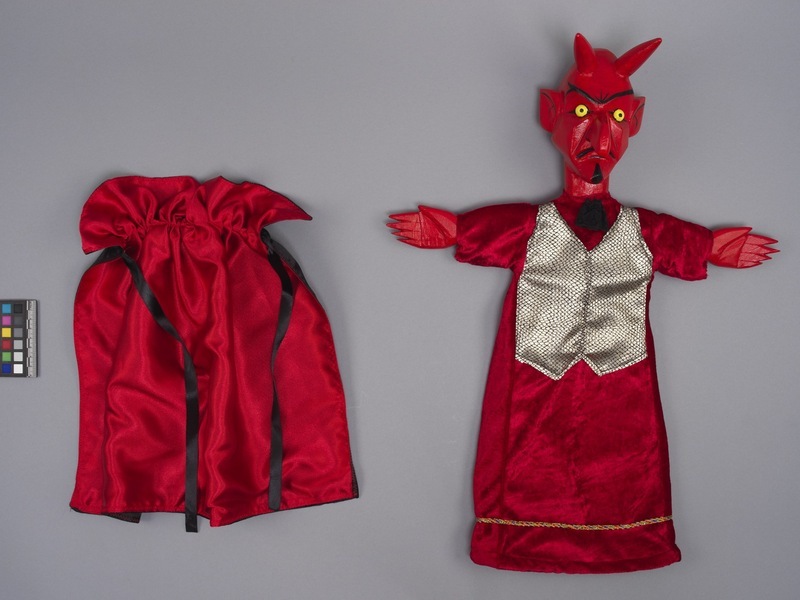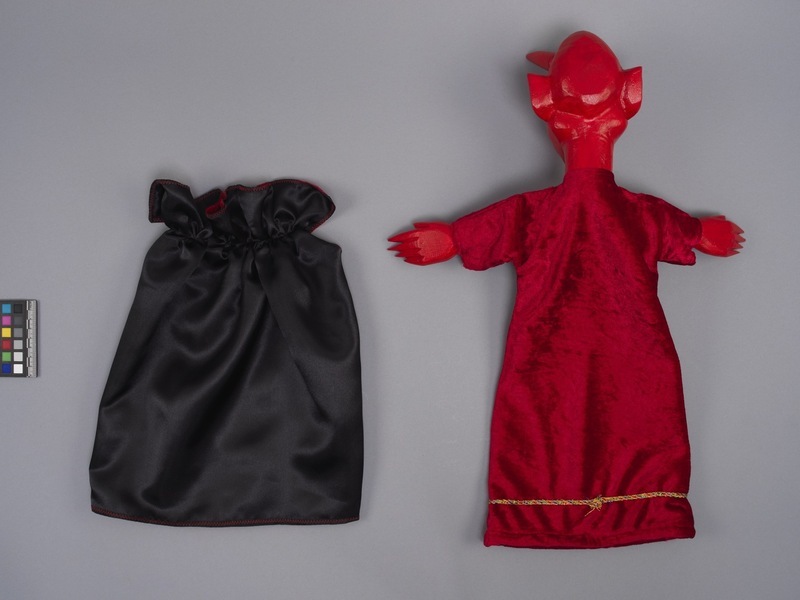Hand Puppet Item Number: 3350/9 a-b from the MOA: University of British Columbia


Description
Devil puppet. Hand puppet of the Devil character, from a Punch and Judy puppet set. Head and hands carved from wood. Components painted dark red. Character has protruding chin, hooked nose and pointed ears. Two tall, angled horns on forehead. Has black goatee. Eyes are circlular, and painted yellow with small, black pupils. Black lines on face highlight nostrils, chin, ears, furrowed brow and cheek bones. Frowning mouth is painted black. Has large slanted eyebrows. Fingers have pointed ends. Character is wearing a separate black, satin cape with a red interior (part b). Cape has high, ruffled collar. Wearing a silver-gold vest with black lines, giving it a scaled appearance. Vest only on front side of puppet and is overtop a red, velvet-like robe. Above vest, attached to robe, is a black, lace-like ascot tie. Velvet-like robe has braided trim around the bottom edge. Braid made from small gold, emerald green and dark purple plastic ribbons. Metal ring along bottom edge of body opening. Operated by inserting hand inside the body of the puppet to control the head and hands.
History Of Use
Punch and July is a well-known puppetry tradition in England, UK. The first recorded show took place in London in 1662, but the tradition dates back to 16th century Italian commedia dell’arte and the character Punchinello. The performance is a series of skits full of humour, violent episodes, political satire, and puns, with audience participation encouraged. The main characters are Mr. Punch, his long-suffering wife Judy, their baby, and a host of set characters: the Policeman, the Devil, the Ghost, the Doctor, the Crocodile, Joey the Clown, Toby the Dog, etc. (from Shadow, Strings & Other Things, 2019).
Specific Techniques
Brian Davey first draws a layout grid and outlines the contours of the puppet’s head on a block of lime (linden) wood. He then carves it out using a combination of electric band and hand saws. For the hooked nose and pointy chins, he carves these features separately from oak wood and then attaches them to the lime wood head with a mortise-and-tenon joint. After sanding the puppet’s head by hand to a smooth and silky finish, Brian paints it with a primer and several layers of acrylic gesso. For other features such as the brows, eyes and mouth he uses a paintbrush and layer of acrylic paint.
Item History
- Made by Alison Davey (Maker) and Brian Davey (Maker) in United Kingdom and Axminster, Devon, England during 2019
- Owned by The Puppetree Company before March 19, 2019
- Received from The Puppetree Company (Seller) and Museum of Anthropology Exhibitions Budget (Funding source) on March 19, 2019
What
- Name
- Hand Puppet
- Identification Number
- 3350/9 a-b
- Type of Item
- puppet
- Material
- fibre, linden wood, acrylic paint, plastic, metal and oak wood
- Overall
- height 53.9 cm, width 43.4 cm, depth 12.7 cm
Who
- Culture
- English
- Creator
- Alison Davey (Maker) and Brian Davey (Maker)
- Previous Owner
- The Puppetree Company
- Received from
- The Puppetree Company (Seller) and Museum of Anthropology Exhibitions Budget (Funding source)
Where
- Holding Institution
- MOA: University of British Columbia
- Made in
- United Kingdom and Axminster, Devon, England
When
- Creation Date
- during 2019
- Ownership Date
- before March 19, 2019
- Acquisition Date
- on March 19, 2019
Other
- Condition
- good
- Accession Number
- 3350/0009 a-b